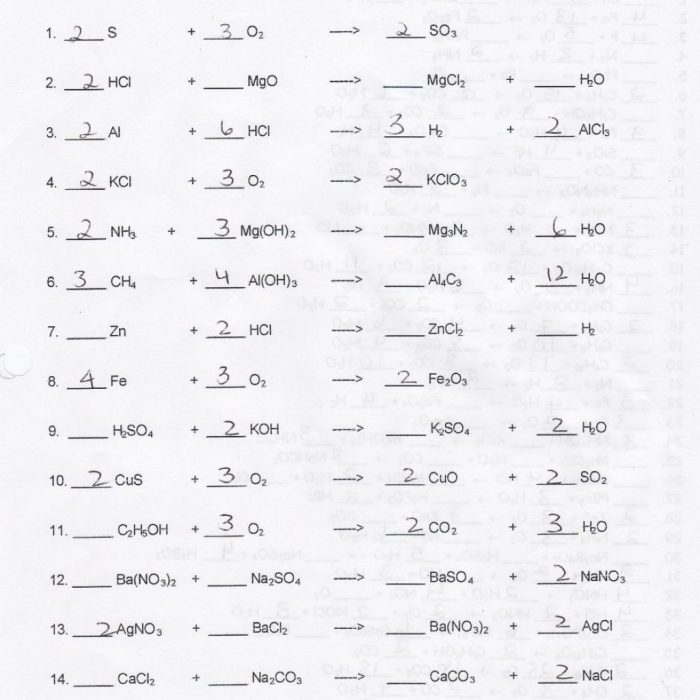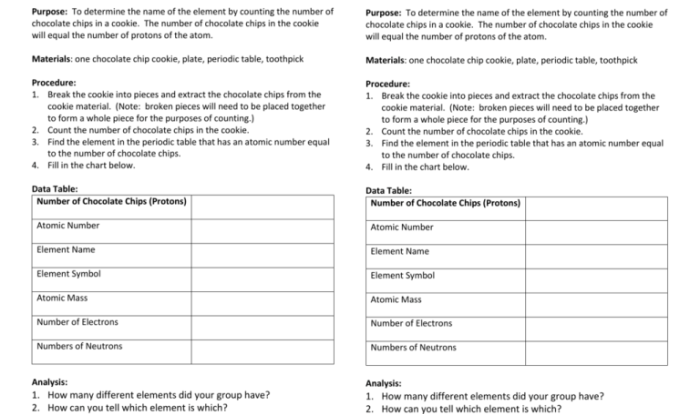Balancing equations chemistry answer key: Delve into the captivating world of chemical equation balancing, where precision meets understanding. This comprehensive guide unlocks the secrets of balancing chemical equations, empowering you with the knowledge to decipher the intricate language of chemical reactions.
Unveiling the fundamental principles, step-by-step methodologies, and real-world applications, this guide serves as your ultimate companion in mastering equation balancing. Prepare to embark on a journey of chemical discovery, where clarity and comprehension reign supreme.
Chemical Equation Balancing Basics

Balancing chemical equations is a crucial aspect of chemistry that allows us to understand and predict the behavior of chemical reactions. It involves adjusting the stoichiometric coefficients of reactants and products to ensure that the number of atoms of each element is equal on both sides of the equation.
To balance an equation, follow these steps:
- Identify the unbalanced equation.
- Count the number of atoms of each element on both sides of the equation.
- Adjust the stoichiometric coefficients of the reactants and products to balance the number of atoms of each element.
- Check if the equation is balanced by verifying that the number of atoms of each element is equal on both sides.
Methods for Balancing Equations
There are several methods for balancing chemical equations, including:
- Inspection method:This method involves balancing the equation by trial and error, adjusting the stoichiometric coefficients until the equation is balanced.
- Half-reaction method:This method is used for balancing redox reactions. It involves splitting the reaction into two half-reactions, one for oxidation and one for reduction, and then balancing each half-reaction separately before combining them.
- Oxidation-reduction method:This method is also used for balancing redox reactions. It involves assigning oxidation numbers to each atom in the reaction and then using the change in oxidation numbers to determine the number of electrons transferred.
Importance of Balanced Equations
Balanced equations are essential for understanding chemical reactions because they provide the following information:
- The stoichiometry of the reaction, which tells us the relative amounts of reactants and products involved.
- The products that will be formed and the quantities in which they will be produced.
- The energy changes that occur during the reaction.
Applications of Balancing Equations, Balancing equations chemistry answer key
Balanced equations are used in various fields, including:
- Stoichiometry:To calculate the amount of reactants or products needed or produced in a reaction.
- Thermodynamics:To determine the heat released or absorbed during a reaction.
- Chemical engineering:To design and optimize chemical processes.
- Environmental chemistry:To understand and mitigate the impact of chemical reactions on the environment.
Common Mistakes in Balancing Equations
Common mistakes made while balancing equations include:
- Changing the chemical formulas of the reactants or products.
- Adding or removing atoms from the equation.
- Not balancing the number of atoms of each element on both sides of the equation.
Practice and Examples
Example 1:Balance the following equation:
H2+ O 2→ H 2O
Solution:
H2+ O 2→ 2H 2O
Example 2:Balance the following redox reaction using the half-reaction method: Fe + Cu 2+→ Fe 2++ Cu Solution:Oxidation half-reaction:Fe → Fe 2++ 2e –Reduction half-reaction:Cu 2++ 2e –→ Cu Overall balanced equation:Fe + Cu 2+→ Fe 2++ Cu
Advanced Techniques
For complex or redox reactions, advanced techniques for balancing equations may be required, such as:
- Matrix method:This method involves setting up a matrix of the stoichiometric coefficients and solving it to find the balanced equation.
- Computer software:Several computer software programs are available to help balance chemical equations.
Answers to Common Questions: Balancing Equations Chemistry Answer Key
What is the significance of balancing chemical equations?
Balancing chemical equations is crucial as it ensures that the number of atoms of each element on the reactants’ side matches the number of atoms of the same element on the products’ side. This adherence to the law of conservation of mass allows us to accurately predict the stoichiometry and outcomes of chemical reactions.
What are the common methods used for balancing chemical equations?
There are several methods for balancing chemical equations, including the inspection method, the oxidation-reduction method, and the half-reaction method. Each method has its advantages and is suitable for different types of reactions.
How can I avoid common mistakes while balancing chemical equations?
To avoid errors, it is essential to pay attention to the coefficients in front of each chemical formula, ensuring they are adjusted correctly to balance the equation. Additionally, double-checking your work by verifying that the number of atoms of each element is the same on both sides is crucial.


